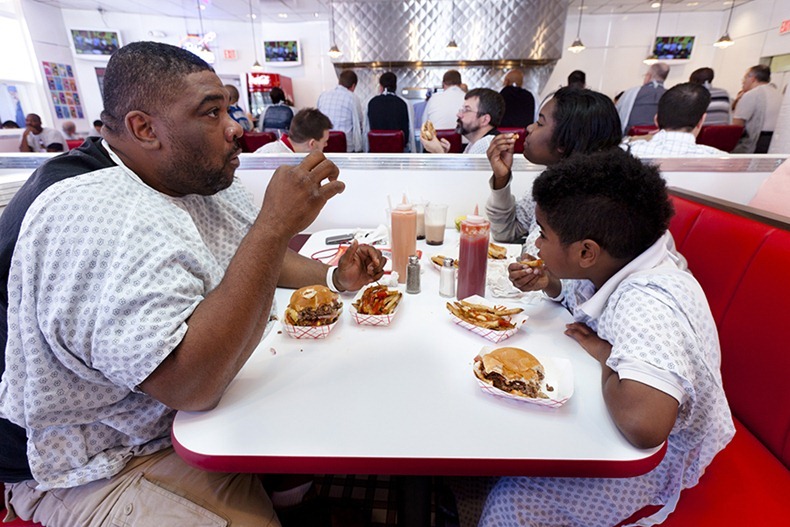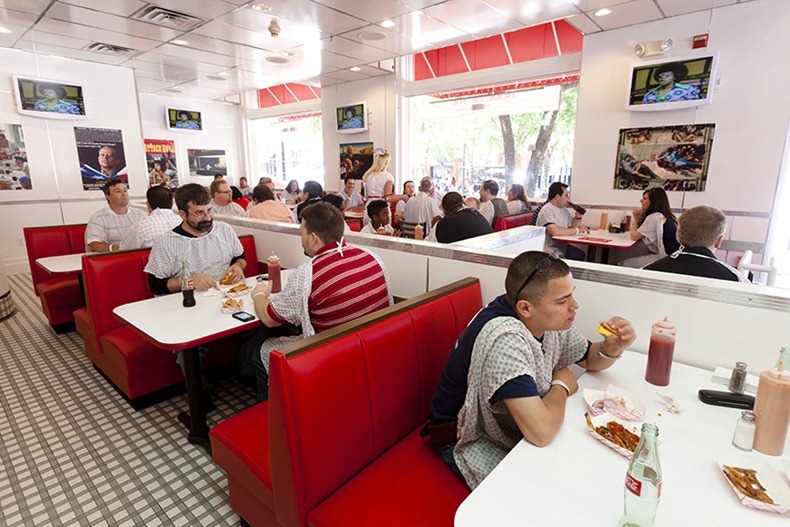The Heart Attack Grill is an outrageously unhealthy, hospital-themed, American fast food hamburger restaurant in Dallas, Texas, that serves high-calorie items with deliberately provocative names. This over-the-top eating establishment, whose tag line is “Taste worth Dying For,” has become internationally recognized for embracing and promoting an unhealthy diet of incredibly large hamburgers and greasy fries.
The menu includes "Single", "Double", "Triple", and "Quadruple Bypass" hamburgers, ranging from 230 to 910 g of beef, "Flatliner Fries" cooked in pure unadulterated lard, and “ButterFat Shake” with the world’s highest butter fat content, so their website says. The "Quadruple Bypass Burger", the biggest item on the menu, is made of four meat patties totaling 2 pounds, practically a whole tomato and about half an onion, 8 slices of cheese and 16 slices of bacon for a total of 8,000 calories.
Jon Basso poses with waitress Mary Brasda, dressed as a nurse, inside his fast food restaurant, "The Heart Attack Grill"
Customers are referred to as “patients,” their orders are called “prescriptions,” and the scantily clad, cleavage-baring waitresses act as “nurses”. A tag is wrapped on the patient's wrist showing which foods they order and a "doctor" examines the "patients" with a stethoscope. Customers who weigh over 350 lb (160 kg) are served free food. Anyone who finish a Triple or Quadruple Bypass Burger are rewarded by wheeling them out of the restaurant in a wheelchair by their "personal nurse”. This is a restaurant that clearly intends to kill you, and they are very forthcoming about it.
Heart Attack Grill was founded in 2005 by Jon Basso with the declared intent of serving "nutritional pornography", food "so bad for you it's shocking". Basso, a former personal fitness trainer and nutritionist, came up with the idea while writing a marketing thesis about fitness training studios. He was intrigued by stories about his clients who were cheating on their diets and decided to open up a restaurant where patrons could come to have fun and leave their clean, healthy lifestyles behind.
Heart Attack Grill has achieved acclaim and attention by deliberately courting controversy as a marketing strategy. The popularity of the restaurant comes through word-of-mouth and widely circulated news stories that continue to keep his trademarked food and controversial practices in the media spotlight.



Photos: Frederic Neema / LUZphoto
Heart Attack Grill previously on Amusing Planet.



























Please take down these copyrighted pictures immediately as they are my property and you have not paid to use them.
ReplyDeleteThank you
Frederic Neema / picstock.com
I studied copyright law for my position running a production company and producing films. This is NOT how copyright works and I'm surprised so many still do know it! Unless you are SELLING your photos and they are actually copyrighted w the Library of Congress, once you post them online, you have allowed them to be copied! They cannot be sold or used for profit but they CAN be saved and used on website. That is the new law. This is why companies that sell stock photos (had to buy some for documentaries before) alter them and post online a version w low pixelation and featuring a logo in the center, albeit an almost transparent one. Once you place an order, you get the full sized w no mark version. Get your info right, people!
ReplyDeleteCurrent Fair Use image copyright laws say that you’re financially liable for posting copyrighted images, even if:
DeleteYou did it by accident
You immediately take down the picture after receiving a DMCA takedown notice
The picture is resized
If the picture is licensed to your web developer (Getty Images requires that you get your own license, thankyouverymuch)
You link back to the photo source and cite the photographer’s name
Your site isn’t commercial and you make no money from your blog
You have a disclaimer on the site
The pic is embedded instead of saved on your server
You found it on the Internet (that’s not an excuse!)
If you use copyrighted images, you will get caught sooner or later. People who create copyrighted works hire companies that use computer programs to scour web pages for copies of those images. It takes time to find them, but the process is automated and runs 24 hours a day, 7 days a week. If you post something that's copyrighted on a blog page that has links pointing to it and the author wants to monitor that particular image, an unauthorized use of it WILL be found eventually.
Don't take anything from the Internet, or anywhere else, because it is almost always copyrighted, by default. "I found it on the Internet" is not a defense against copyright infringement; works on the Internet are as copyrightable as any other kind of work. Nor is "it didn't say it was copyrighted."
DeleteIn nearly all jurisdictions, including the United States, and all other Berne Convention signatories, it is not necessary for a work to have an explicit copyright notice for it to be copyrighted.[2] It is also not necessary for copyright in a work to be registered; this simply makes it easier to be compensated in court. Without an explicit dedication to the public domain, assume that it is still under copyright.
There is a quirk in the United States' implementation of the Berne Convention: works first published before 1978 without a copyright notice may be public domain in the United States.[3] Works published under copyright notice are no longer covered by copyright after 75 years. They become public domain material. Works published by the US Government are public domain no matter when they were published.